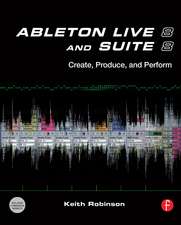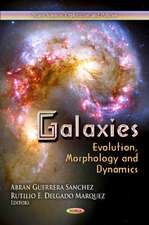Spectroscopy: The Key to the Stars: Reading the Lines in Stellar Spectra: The Patrick Moore Practical Astronomy Series
Autor Keith Robinsonen Limba Engleză Paperback – 16 ian 2007
Din seria The Patrick Moore Practical Astronomy Series
-
 Preț: 258.21 lei
Preț: 258.21 lei -
 Preț: 164.94 lei
Preț: 164.94 lei -
 Preț: 324.21 lei
Preț: 324.21 lei -
 Preț: 255.10 lei
Preț: 255.10 lei - 8%
 Preț: 581.98 lei
Preț: 581.98 lei -
 Preț: 159.16 lei
Preț: 159.16 lei -
 Preț: 282.38 lei
Preț: 282.38 lei -
 Preț: 308.55 lei
Preț: 308.55 lei -
 Preț: 309.87 lei
Preț: 309.87 lei -
 Preț: 332.98 lei
Preț: 332.98 lei -
 Preț: 276.91 lei
Preț: 276.91 lei -
 Preț: 243.94 lei
Preț: 243.94 lei -
 Preț: 183.40 lei
Preț: 183.40 lei -
 Preț: 378.09 lei
Preț: 378.09 lei -
 Preț: 302.20 lei
Preț: 302.20 lei -
 Preț: 210.01 lei
Preț: 210.01 lei -
 Preț: 212.68 lei
Preț: 212.68 lei -
 Preț: 271.39 lei
Preț: 271.39 lei -
 Preț: 252.91 lei
Preț: 252.91 lei -
 Preț: 281.95 lei
Preț: 281.95 lei -
 Preț: 289.85 lei
Preț: 289.85 lei -
 Preț: 218.84 lei
Preț: 218.84 lei -
 Preț: 282.38 lei
Preț: 282.38 lei -
 Preț: 128.86 lei
Preț: 128.86 lei -
 Preț: 301.10 lei
Preț: 301.10 lei -
 Preț: 204.78 lei
Preț: 204.78 lei -
 Preț: 307.44 lei
Preț: 307.44 lei -
 Preț: 303.07 lei
Preț: 303.07 lei -
 Preț: 258.83 lei
Preț: 258.83 lei -
 Preț: 155.25 lei
Preț: 155.25 lei -
 Preț: 193.97 lei
Preț: 193.97 lei -
 Preț: 208.26 lei
Preț: 208.26 lei -
 Preț: 279.09 lei
Preț: 279.09 lei -
 Preț: 303.51 lei
Preț: 303.51 lei -
 Preț: 277.54 lei
Preț: 277.54 lei -
 Preț: 208.51 lei
Preț: 208.51 lei -
 Preț: 214.86 lei
Preț: 214.86 lei -
 Preț: 304.58 lei
Preț: 304.58 lei -
 Preț: 220.57 lei
Preț: 220.57 lei -
 Preț: 157.32 lei
Preț: 157.32 lei -
 Preț: 275.98 lei
Preț: 275.98 lei -
 Preț: 288.98 lei
Preț: 288.98 lei -
 Preț: 261.49 lei
Preț: 261.49 lei -
 Preț: 279.09 lei
Preț: 279.09 lei -
 Preț: 160.82 lei
Preț: 160.82 lei -
 Preț: 327.01 lei
Preț: 327.01 lei -
 Preț: 254.90 lei
Preț: 254.90 lei -
 Preț: 304.38 lei
Preț: 304.38 lei -
 Preț: 256.84 lei
Preț: 256.84 lei
Preț: 272.92 lei
Nou
52.22€ • 54.52$ • 43.22£
Carte disponibilă
Livrare economică 14-28 martie
Specificații
ISBN-10: 0387367861
Pagini: 160
Ilustrații: XII, 160 p. 87 illus.
Dimensiuni: 155 x 235 x 9 mm
Greutate: 0.3 kg
Ediția:2007
Editura: Springer
Colecția Springer
Seria The Patrick Moore Practical Astronomy Series
Locul publicării:New York, NY, United States
Public țintă
Popular/generalCuprins
Spectroscopy—A New Golden Age for Amateur Astronomy.- The Basic Stuff—Light Radiation and Atoms.- Behind the Lines—The Magnificent Energy Level Structure of an Atom.- Our Old Friend the Doppler Effect.- When Is a Spectral Line Not a Spectral Line?.- Stellar Spectra and That Famous Mnemonic.- Cool but not Smooth—The Molecular Spectra of Red Stars.- Glows in the Dark—Emission Lines and Nebulae.- Glowing Vortices—Accretion Disks.- The P Cygni Profile and Friends.- Spectral Magnetism—The Zeeman Effect.- ‘How Much Gold in Them There Stars?’—The Curve of Growth.
Recenzii
"If you ever wondered what the big deal is about spectroscopy or wished you understood it a little better, this book’s for you. Robinson takes a step-by-step approach to spectroscopy, each chapter building on the ones before it. … The book is a worthy addition to any advanced amateur astronomer’s library." (Michael Bakich, Astronomy, February, 2007)
"In this informative monograph, Robinson (Royal Astronomical Society) explains the basic concepts in terms that a general reader can master. Topics such as the characteristic radiation expected to be emitted by atoms, by ionized gas, and by molecules are addressed using illustrations and word descriptions of the physical processes. … the interested reader will find this book a stimulating introduction. Summing Up: Recommended. General readers; lower-division undergraduates." (D. E. Hogg, CHOICE, Vol. 44 (11), July, 2007)
"In Spectroscopy: The Key to the Stars, Keith Robinson makes spectroscopy approachable for those who are interested in expanding their observational repertoire. … Not only is this a good read for any observer thinking of taking up spectroscopy, but it’s also suitable for high school or first-year college students in astronomy and physics." (Carolyn Collins Petersen, Sky & Telescope, Vol. 115 (1), January, 2008)
"This is a small book (160 pages) written for amateur astronomers who use CCD cameras and include spectroscopy as part of their observational program. The main purpose of the book is to describe the physics and the physical processes behind the stellar spectra. … the topics considered are clearly and concisely described. The amateur astronomers, who are not familiar with physics or who have forgotten the essentials of this science, will read it … with interest and pleasure." (Emile Biemont, Physicalia Magazine, Vol. 29 (4), 2007)
Notă biografică
Keith Robinson obtained a degree in physics from the University of Lancaster, and is a Fellow of the Royal Astronomical Society.
Textul de pe ultima copertă
More can be learned about physical processes going on in stars and nebulae by understanding and analyzing their spectra than by any other means.
Many amateur astronomers who use CCD cameras are taking up spectroscopy as part of their observational program, but until now the physics that underlies astronomical spectroscopy has been confined to advanced academic books.
Not any more!
In Spectroscopy – the Key to the Stars, Keith Robinson describes the physics and physical processes that cause the stellar spectra to be as they are… spectra that amateur astronomers can image with today’s commercially-made equipment. Written specifically for amateur astronomers, this book assumes only a basic knowledge of physics but looks in detail at many topics, including energy levels in atoms, the molecular spectra of red stars, emission lines in nebulae, and much, much more.
Here is everything you need to know about how the atomic processes in stars and nebulae produce the spectra that amateur astronomers can image, and why spectroscopy is such a powerful tool for astronomers.
Caracteristici
Invaluable to the rapidly-growing number of amateur astronomical spectroscopists
An ideal companion to existing books on observational amateur astronomical spectroscopy, particularly Springer’s Practical Amateur Spectroscopy by Steve Tonkin (2002)
Useful as a reference for astronomy/astrophysics students
Descriere
This is the first non-technical book on spectroscopy written specifically for practical amateur astronomers. It includes all the science necessary for a qualitative understanding of stellar spectra, but avoids a mathematical treatment which would alienate many of its intended readers. Any amateur astronomer who carries out observational spectroscopy and who wants a non-technical account of the physical processes which determine the intensity and profile morphology of lines in stellar spectra will find this is the only book written specially for them. It is an ideal companion to existing books on observational amateur astronomical spectroscopy.









